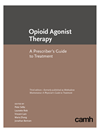Text adapted in 2023 from Opioid Use and Opioid Use Disorders in The Primary Care Addiction Toolkit. Available online only.
Prescribing methadone
As of May 2018, Health Canada has removed federal exemptions for physicians to prescribe and provide methadone to their patients. Prescribers and pharmacists must still meet all other provisions of the Narcotic Control Regulations, as well as requirements set by their province or territory or the licensing authority for safe prescribing.
How methadone works
Methadone is a synthetic oral full mu opioid agonist with effects similar to those of morphine. Its unique pharmacological properties make methadone effective in the treatment of opioid use disorder. Methadone has a slow onset and long duration of action and does not cause intoxication or sedation.
Patients on an optimal daily dose of methadone experience relief of withdrawal symptoms and cravings for 24 hours, and are able to function normally without sedation or euphoria.
Methadone safety
Methadone has an average half-life of 25 hours (range: 13–47 hours). It is readily absorbed from the small intestine, and with repeated dosing leads to a gradual accumulation of methadone in the serum. Steady state can be achieved after four to five half-lives, or approximately three to seven days of dosing. Clinically, this means that a methadone dose that is barely adequate on day 1 could cause a fatal overdose on day 5 due to respiratory depression if the initial dose is too high. Strict dosing protocols help prescribers identify patients who are at higher risk of methadone toxicity and who may benefit from a lower induction dose.
Higher doses of methadone may be associated with a prolonged QT interval and arrhythmias such as torsades de pointes, which can be fatal. Baseline ECG is recommended, but lack of access to testing should not be a barrier to receiving methadone. The ECG should be repeated if the methadone dose reaches 120 mg or if the patient experiences cardiac symptoms or has pre-existing risk factors (American Society of Addiction Medicine, 2020; Centre for Addiction and Mental Health [CAMH], 2021).
Methadone also has the potential for adverse interactions with other medications, such as antibiotics and antidepressants, or if it is taken with other medications known to cause QT prolongation (Bruneau et al., 2018).
Methadone reduces the risk of overdose among patients who use fentanyl. Reaching a therapeutic dose safely and quickly increases retention in treatment. Patients who use fentanyl may require faster titration of methadone and may need therapeutic doses of 100 mg of methadone or higher due to higher opioid tolerance (Bromley et al., 2021).
Candidates for methadone treatment
Methadone may be the most appropriate opioid agonist therapy (OAT) option for patients who (CAMH, 2021; Canadian Research Initiative in Substance Misuse, 2018):
- prefer methadone over buprenorphine-naloxone
- show an inadequate or poor response to buprenorphine-naloxone
- have very high opioid tolerance. Higher doses of methadone may be more effective than buprenorphine for treatment retention among patients with addiction to illicit opioids such as fentanyl (Bromley et al., 2021).


